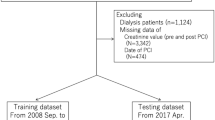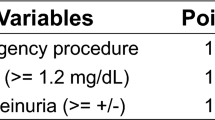Abstract
Acute kidney injury (AKI) is common in patients undergoing percutaneous coronary intervention (PCI). One risk factor for AKI is periprocedural hemoglobin drop level (> 3 g/dL); however, whether the relationship between hemoglobin drop and AKI is linear or nonlinear remains unknown. We aimed to investigate the relationship between periprocedural hemoglobin drop and AKI after PCI. We evaluated 14,273 consecutive patients undergoing PCI between September 2008 and March 2019. AKI was defined as an absolute or a relative increase in serum creatinine level of 0.3 mg/dL or 50%, respectively. Restricted cubic spline was constructed to assess the association between hemoglobin drop and AKI by logistic regression and machine learning (ML) models, which were used to predict the risk of AKI. The patients’ mean age was 68.4 ± 11.6 years; the AKI incidence was 10.5% (N = 1499). An absolute > 3 g/dL or 20% relative decrease in hemoglobin level was an independent predictor of AKI incidence (odds ratio, OR [95% confidence interval, CI]: 2.24 [1.92–2.61], P < 0.001; 2.35 [2.04–2.71], P < 0.001, respectively). An adjusted restricted cubic spline demonstrated that absolute/relative decrease in hemoglobin was linearly associated with AKI. Logistic and ML models with absolute/relative hemoglobin changes were comparable while estimating the risk of AKI (absolute area under the curve [AUC] (logistic):0.826, AUC (ML): 0.820; relative AUC (logistic): 0.818, AUC (ML): 0.816). An absolute/relative decrease in periprocedural hemoglobin after PCI was linearly associated with AKI. Detection of a relative/absolute decrease in hemoglobin may help clinicians identify individuals as high risk for AKI after PCI.


Similar content being viewed by others
References
Rihal CS, Textor SC, Grill DE, Berger PB, Ting HH, Best PJ, Singh M, Bell MR, Barsness GW, Mathew V, Garratt KN, Holmes DR Jr (2002) Incidence and prognostic importance of acute renal failure after percutaneous coronary intervention. Circulation 105:2259–2264
Marenzi G, Lauri G, Assanelli E, Campodonico J, De Metrio M, Marana I, Grazi M, Veglia F, Bartorelli AL (2004) Contrast-induced nephropathy in patients undergoing primary angioplasty for acute myocardial infarction. J Am Coll Cardiol 44:1780–1785
Araujo GN, Pivatto Junior F, Fuhr B, Cassol EP, Machado GP, Valle FH, Bergoli LC, Wainstein RV, Polanczyk CA, Wainstein MV (2018) Simplifying contrast-induced acute kidney injury prediction after primary percutaneous coronary intervention: the age, creatinine and ejection fraction score. Cardiovasc Interv Ther 33:224–231
Chandiramani R, Cao D, Nicolas J, Mehran R (2020) Contrast-induced acute kidney injury. Cardiovasc Interv Ther 35:209–217
Ohno Y, Maekawa Y, Miyata H, Inoue S, Ishikawa S, Sueyoshi K, Noma S, Kawamura A, Kohsaka S, Fukuda K (2013) Impact of periprocedural bleeding on incidence of contrast-induced acute kidney injury in patients treated with percutaneous coronary intervention. J Am Coll Cardiol 62:1260–1206
Numasawa Y, Ueda I, Sawano M, Kuno T, Kodaira M, Noma S, Suzuki M, Miyata H, Fukuda K, Kohsaka S (2018) Relation of baseline hemoglobin level to in-hospital outcomes in patients who undergo percutaneous coronary intervention (from a Japanese Multicenter Registry). Am J Cardiol 121:695–702
Mehran R, Rao SV, Bhatt DL, Gibson CM, Caixeta A, Eikelboom J, Kaul S, Wiviott SD, Menon V, Nikolsky E, Serebruany V, Valgimigli M, Vranckx P, Taggart D, Sabik JF, Cutlip DE, Krucoff MW, Ohman EM, Steg PG, White H (2011) Standardized bleeding definitions for cardiovascular clinical trials: a consensus report from the Bleeding Academic Research Consortium. Circulation 123:2736–2747
Choi JH, Seo JM, Lee DH, Park K, Kim YD (2015) Clinical utility of new bleeding criteria: a prospective study of evaluation for the Bleeding Academic Research Consortium definition of bleeding in patients undergoing percutaneous coronary intervention. J Cardiol 65:324–329
Kuno T, Kohsaka S, Numasawa Y, Ueda I, Suzuki M, Nakamura I, Negishi K, Ishikawa S, Maekawa Y, Kawamura A, Miyata H, Fukuda K (2015) Location of the culprit coronary lesion and its association with delay in door-to-balloon time (from a multicenter registry of primary percutaneous coronary intervention). Am J Cardiol 115:581–586
Kuno T, Numasawa Y, Miyata H, Takahashi T, Sueyoshi K, Ohki T, Negishi K, Kawamura A, Kohsaka S, Fukuda K (2013) Impact of coronary dominance on in-hospital outcomes after percutaneous coronary intervention in patients with acute coronary syndrome. PLoS ONE 8:e72672
Hirota Y, Sawano M, Numasawa Y, Ueda I, Noma S, Suzuki M, Hayashida K, Yuasa S, Maekawa Y, Kohsaka S, Fukuda K (2018) Characteristics and in-hospital outcomes in young patients presenting with acute coronary syndrome treated by percutaneous coronary intervention. Cardiovasc Interv Ther 33:154–162
Inohara T, Kohsaka S, Miyata H, Ueda I, Maekawa Y, Fukuda K, Cohen DJ, Kennedy KF, Rumsfeld JS, Spertus JA (2016) Performance and validation of the U.S. NCDR Acute Kidney Injury Prediction Model in Japan. J Am Coll Cardiol 67:1715–1722
Kuno T, Numasawa Y, Sawano M, Katsuki T, Kodaira M, Ueda I, Suzuki M, Noma S, Negishi K, Ishikawa S, Miyata H, Fukuda K, Kohsaka S (2018) Effects of body habitus on contrast-induced acute kidney injury after percutaneous coronary intervention. PLoS ONE 13:e0203352
Roe MT, Messenger JC, Weintraub WS, Cannon CP, Fonarow GC, Dai D, Chen AY, Klein LW, Masoudi FA, McKay C, Hewitt K, Brindis RG, Peterson ED, Rumsfeld JS (2010) Treatments, trends, and outcomes of acute myocardial infarction and percutaneous coronary intervention. J Am Coll Cardiol 56:254–263
Anderson HV, Shaw RE, Brindis RG, McKay CR, Klein LW, Krone RJ, Ho KK, Rumsfeld JS, Smith SC Jr, Weintraub WS (2007) Risk-adjusted mortality analysis of percutaneous coronary interventions by American College of Cardiology/American Heart Association guidelines recommendations. Am J Cardiol 99:189–196
Kohsaka S, Miyata H, Ueda I, Masoudi FA, Peterson ED, Maekawa Y, Kawamura A, Fukuda K, Roe MT, Rumsfeld JS, JCDKiCS JCDNcdr (2015) An international comparison of patients undergoing percutaneous coronary intervention: a collaborative study of the National Cardiovascular Data Registry (NCDR) and Japan Cardiovascular Database-Keio interhospital Cardiovascular Studies (JCD-KiCS). Am Heart J 170:1077–1085
Mehta RL, Kellum JA, Shah SV, Molitoris BA, Ronco C, Warnock DG, Levin A, Acute Kidney Injury N (2007) Acute Kidney Injury Network: report of an initiative to improve outcomes in acute kidney injury. Crit Care 11:R31
McCullough PA, Sandberg KR (2003) Epidemiology of contrast-induced nephropathy. Rev Cardiovas Med 4(Suppl 5):S3–9
Mehta SK, Frutkin AD, Lindsey JB, House JA, Spertus JA, Rao SV, Ou FS, Roe MT, Peterson ED, Marso SP, National Cardiovascular Data R (2009) Bleeding in patients undergoing percutaneous coronary intervention: the development of a clinical risk algorithm from the National Cardiovascular Data Registry. Cir Cardiovasc Interv 2:222–229
Tsai TT, Patel UD, Chang TI, Kennedy KF, Masoudi FA, Matheny ME, Kosiborod M, Amin AP, Weintraub WS, Curtis JP, Messenger JC, Rumsfeld JS, Spertus JA (2014) Validated contemporary risk model of acute kidney injury in patients undergoing percutaneous coronary interventions: insights from the National Cardiovascular Data Registry Cath-PCI Registry. J Am Heart Assoc 3:e001380
Matsuo S, Imai E, Horio M, Yasuda Y, Tomita K, Nitta K, Yamagata K, Tomino Y, Yokoyama H, Hishida A, Collaborators developing the Japanese equation for estimated GFR (2009) Revised equations for estimated GFR from serum creatinine in Japan. Am J Kidney Dis 53:982–992
Sharma H, Sharma KK (2016) An algorithm for sleep apnea detection from single-lead ECG using Hermite basis functions. Comput Biol Med 77:116–124
Pinto JR, Cardoso JS, Lourenco A, Carreiras C (2017) Towards a continuous biometric system based on ECG signals acquired on the steering wheel. Sensors (Basel) 17:2228
Ndrepepa G, Kastrati A (2015) Minimising bleeding during percutaneous coronary intervention. BMJ 350:h1395
Grossman PM, Gurm HS, McNamara R, Lalonde T, Changezi H, Share D, Smith DE, Chetcuti SJ, Moscucci M, Blue Cross Blue Shield of Michigan CardiovascularC (2009) Percutaneous coronary intervention complications and guide catheter size: bigger is not better. JACC Cardiovasc Interv 2:636–644
Mehran R, Dangas GD, Weisbord SD (2019) Contrast-associated acute kidney injury. N Engl J Med 380:2146–2155
Gupta RK, Bang TJ (2010) Prevention of contrast-induced nephropathy (CIN) in interventional radiology practice. Semin Intervent Radiol 27:348–359
Baky V, Moran D, Warwick T, George A, Williams T, McWilliams E, Marine JE (2018) Obtaining a follow-up appointment before discharge protects against readmission for patients with acute coronary syndrome and heart failure: a quality improvement project. Int J Cardiol 257:12–15
Acknowledgment
The authors thank all the investigators, clinical coordinators, and institutions involved in the JCD- KiCS. Investigators Yohei Numasawa, Masaki Kodaira (Japanese Red Cross Ashikaga Hospital), Yutaka Okada (Eiju General Hospital), Soushin Inoue, Iwao Nakamura (Hino Municipal Hospital), Takaharu Katayama, Shunsuke Takagi, Takashi Matsubara (Hiratsuka City Hospital), Masashi Takahashi, Keishu Li, Koichiro Sueyoshi (Kawasaki City Municipal Hospital), Taku Inohara, Fumiaki Yashima, Atsushi Anzai, Kentaro Hayashida, Takashi Kawakami, Hideaki Kanazawa, Shunsuke Yuasa, Yuichiro Maekawa (Keio University School of Medicine), Masahiro Suzuki, Keisuke Matsumura (National Hospital Organization Saitama National Hospital) Yukinori Ikegami, Jun Fuse, Munehisa Sakamoto, Yukihiko Momiyama (National Hospital Organization Tokyo Medical Center), Ayaka Endo, Tasuku Hasegawa, Toshiyuki Takahashi, Susumu Nakagawa (Saiseikai Central Hospital), Takashi Yagi, Koji Ueno, Kenichiro Shimoji, Shigetaka Noma (Saiseikai Utsunomiya Hospital), Masahito Munakata, Takashi Akima, Shiro Ishikawa, Takashi Koyama (Saitama City Hospital), Atsushi Mizuno, Yutaro Nishi (St Luke’s International Hospital Heart Center), Toshimi Kageyama, Kazunori Moritani, Masaru Shibata (Tachikawa Kyosai Hospital), Kimi Koide, Yoshinori Mano, Takahiro Oki (Tokyo Dental College Ichikawa General Hospital), Daisuke Shinmura, Koji Negishi, Yusuke Jo, and Takahiro Koura (Yokohama Municipal Hospital). Clinical Coordinators Junko Susa, Ayano Amagawa, Hiroaki Nagayama, Miho Umemura, Itsuka Saito, and Ikuko Ueda.
Funding
This research study was supported by a grant from the Ministry of Education, Culture, Sports, Science, and Technology, Japan (KAKENHI No. 25460630 and No. 25460777). Grant-in-Aid from the Japanese Ministry of Health, Labor and Welfare (No. H29-Refractory Disease-034).
Author information
Authors and Affiliations
Corresponding author
Ethics declarations
Conflict of interest
Dr. Kohsaka received a research grant for the Department of Cardiology, Keio University School of Medicine from Bayer Pharmaceutical Co., Ltd and Daiichi Sankyo Co., Ltd. but the funder did not have any role in the study design, data collection, data analysis, decision to publish, or manuscript preparation. All the authors have no conflicts of interest to disclose.
Ethical approval and IRB Information
The present study was approved by the IRB Committee of Keio University (Reference Number: 20080073).
Additional information
Publisher's Note
Springer Nature remains neutral with regard to jurisdictional claims in published maps and institutional affiliations.
Rights and permissions
About this article
Cite this article
Kuno, T., Numasawa, Y., Mikami, T. et al. Association of decreasing hemoglobin levels with the incidence of acute kidney injury after percutaneous coronary intervention: a prospective multi-center study. Heart Vessels 36, 330–336 (2021). https://doi.org/10.1007/s00380-020-01706-w
Received:
Accepted:
Published:
Issue Date:
DOI: https://doi.org/10.1007/s00380-020-01706-w




